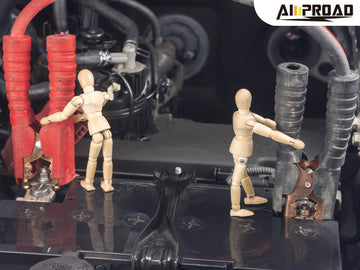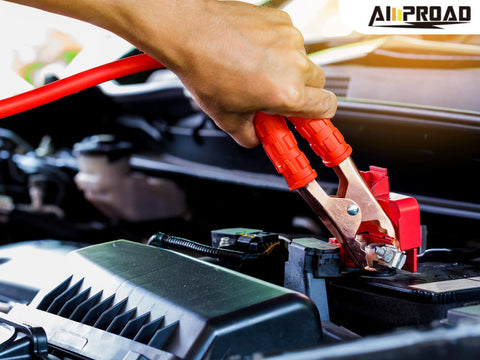
A dead battery need not spell disaster thanks to an array of reliable starting solutions in modern automotive technology. Portable jump starters deliver independent power on demand, while traditional jumper cables facilitate vehicle-to-vehicle assistance. Jump boxes bridge these approaches by offering standalone power in a compact package. Each of these tools serves as a dependable ally against unexpected battery failures, providing drivers with convenient options to get their vehicles running again. Through careful equipment selection, motorists can match their specific needs with the most suitable battery revival solution.
What Is A Jump Starter?
A jump starter is the unsung hero of every driver's toolkit, providing a lifeline for how to boost a car when your car refuses to budge. Here's a breakdown of its essential features:
Portable Power Source: Imagine a compact powerhouse that doesn't rely on external help. That's the jump starter—a standalone, portable unit armed with its own battery. This means no searching for an available power outlet or depending on another vehicle's kindness. It's a reliable source of power that you can carry with you wherever your journeys take you.
Built-in Cables: No need to fumble around for extra tools. A car battery booster comes with the convenience of built-in cables and clamps. These essential components are ready and waiting, simplifying the process of connecting the jump starter to your car's battery terminals. Just hook them up, and you're ready to revive your vehicle.
Convenience at Its Core: The beauty of a noco jump starter lies in its self-sufficiency. Unlike traditional jump-start methods that require another vehicle's assistance, a jump starts stands alone. It's your knight in shining armor during those lonely "car won't start" moments. Just grab your trusty jump starter, make the connection, and breathe life back into your car.
Picture this: you're stranded in a desolate parking lot, your engine silent. The culprit? A drained battery. This is where a jump starter shines. Its portability ensures that you're never caught off guard. Equipped with its own power source, it transforms into your personal rescue squad, ready to bring your vehicle back to life.
The built-in cables and clamps are your sidekicks in this rescue mission. No need to dig through your trunk for tangled cables or rely on a stranger's willingness to assist. The jump starter's simplicity is its strength—you connect, you start, you go.

Convenience takes center stage with a battery jump starter. It's a standalone savior, always at your beck and call. No more waiting for a fellow driver to lend a hand; you're in control. This self-contained unit embodies the essence of reliability and ease.
To wrap it up, a battery booster isn't just a device; it's your ticket out of a "car won't start" dilemma. With its portable power source, built-in cables, and unmatched convenience, it's a must-have for every driver. So, next time your car plays the silent game, don't fret. Reach for your jump starter and let it work its magic—a testament to the power of preparation and ingenuity on the road.
What Is Jumper Cables?
Jumper cables, a timeless tool in every driver's arsenal, offer a classic solution for the familiar woe of a dead car battery. Here's a closer look at how these cables operate:
Conventional Method: Jumper cables adhere to the conventional method of jump-starting a vehicle. They rely on an external power source, typically another vehicle with a fully functional battery. This method has stood the test of time, providing a straightforward and accessible way to breathe life back into a stalled car.
Direct Connection: The mechanism is simple yet effective—car battery jumper cables require a direct physical connection. The dead battery of one vehicle is linked directly to the functional battery of another. This direct link enables the flow of power from the working battery to the one in need, initiating the jump-start process.
Dependent on Another Vehicle: The efficiency of jumper cables hinges on the presence of a second vehicle. When your car refuses to start, you're reliant on the goodwill of another driver nearby. In essence, the effectiveness of this method is directly proportional to the accessibility of a functioning vehicle willing to lend its power.
While jumper cables have been a reliable go-to for generations, their effectiveness does come with a caveat. If you find yourself in a remote location with no other vehicles in sight, the dependency on another car becomes a significant limitation. The success of the jump-start endeavor is contingent on external factors, emphasizing the need for an alternative solution in scenarios where a helping hand might not be readily available.
In essence, car jumper cables are a dependable and time-tested method, offering a direct link between a dead battery and a functional one. However, their Achilles' heel lies in dependency—your success in reviving your car is intrinsically tied to the presence of another vehicle. While they remain a valuable tool for everyday use, considering alternative options like jump starters or jump boxes adds an extra layer of self-reliance to your roadside preparedness.
What Is A Jump Box?
In the world of automotive rescue, the jump box emerges as a pocket-sized hero, delivering a one-two punch of power and versatility.
Similar to its counterpart, the portable starter jumper, the jump box stands as a compact power unit designed for the on-the-go lifestyle. Its unassuming size belies the robust energy it packs within, making it the ideal companion for those unexpected moments when your car chooses silence over engine roar.

What sets the jump box apart is its autonomy. No longer tethered to the availability of another vehicle, the jumper starter houses a built-in rechargeable battery. This internal power source means you can bid farewell to the days of seeking external help; the jump box is your self-sufficient savior, ever-ready to kick-start your car into action.
But the jump box isn't a one-trick pony. Beyond its primary role of jump-starting your vehicle, many of these compact powerhouses boast additional features. Some double up as portable power banks, equipped with handy USB ports. Imagine your phone's battery on its last legs, far from the comforting embrace of a conventional charging point. Enter the jump box, not only reviving your car but also coming to the rescue of your digital devices.
In closing, the jump box isn't just a tool; it's a multifaceted solution tailored for the modern driver. Its compact design, coupled with a built-in battery and extra features, transforms it into an indispensable companion for your journeys. So, the next time your car decides it's taking a break from starting, reach for your trusty jump box—a true dynamo on the roadside, ready to power up your vehicle and more.
Jump Starter, Jumper Cables, and Jump Box, Which One Should You Choose?
When faced with a dead car battery, the independence, portability, and power source of your chosen tool become pivotal. Jump starters and jump boxes, like those from high-quality and competitively priced manufacturers such as Amproad, take the lead in independence, standing as standalone units that don't require the collaboration of another vehicle. This autonomy ensures that, even in remote locations or solo driving scenarios, you have the means to jump-start your car without depending on external help.
Portability is a game-changer when it comes to addressing unexpected battery challenges. Amproad's jump starters and jumper box is crafted with mobility in mind, designed to be compact and easy to carry. Their portable nature, combined with top-notch quality and competitive pricing, ensures that you can keep them in your vehicle, ready for action whenever the need arises. On the flip side, jumper cables tend to be bulkier and less convenient to carry, potentially limiting their practicality for drivers who prioritize on-the-go solutions.
The power source is where the versatility of Amproad's car jump starter and jump boxe shines. Equipped with their own power sources, usually in the form of built-in rechargeable batteries, these units provide flexibility in various situations. You're not reliant on the power source of another vehicle, allowing you to jump-start your car independently. In contrast, jumper cables rely on the power source of a second vehicle, meaning their effectiveness is contingent on finding assistance.
Here below is a table to help you understand the differences between the three more intuitively.
|
Aspect |
Jump Starters and Jump Boxes |
Jumper Cables |
|
Independence |
Standalone units, do not require another vehicle |
Depend on a second vehicle for assistance |
|
Portability |
Designed to be portable and convenient to carry |
Typically bulkier and less practical for mobility |
|
Power Source |
Have their own built-in rechargeable batteries |
Rely on the power source of another vehicle |
|
Versatility |
Versatile, applicable in various situations |
Effective when assistance is available but less versatile |
|
Usage Scenario |
Suitable for solo drivers, remote locations |
Requires another vehicle's presence, less convenient in certain situations |
Ultimately, understanding the nuances of independence, portability, and power source allows you to choose the tool that aligns with your lifestyle and driving needs. Whether you opt for the standalone reliability of Amproad's jump starters and jump pack or the traditional collaboration of jumper cables, having the right tool on hand ensures that a dead car battery doesn't keep you stranded.

Which One of Them Is the Safest?
When considering safety, jump starters and auto jump box tends to offer a more user-friendly and independent solution. High-quality models often come equipped with safety features such as overcharge protection and reverse polarity protection, minimizing the risk of accidents during the jump-starting process. These devices are designed with clear instructions and interfaces, enhancing overall safety.
On the other hand, jumper cables, while effective when used correctly, may pose a higher risk of user error. The proper connection of positive and negative terminals is crucial, and mistakes in this process can lead to safety hazards. Additionally, jumper cables require coordination with another vehicle, introducing potential safety concerns, especially if the assisting driver is not familiar with jump-starting procedures.
In terms of physical safety, the compact and lightweight designs of jump starters and jump boxes contribute to safer handling and storage, they worth to be invested in case that car won’t start at any time any where. Their quality construction materials enhance durability and overall safety. In contrast, the bulkier nature of jumper cables may pose challenges in handling, increasing the risk of physical strain or tripping hazards.
To sum up, while safety considerations may vary, jump starters and jump boxes, particularly from reputable manufacturers, often provide a safer and more independent solution. However, regardless of the chosen method, strict adherence to safety guidelines and proper usage is essential for a secure jump-starting experience.


